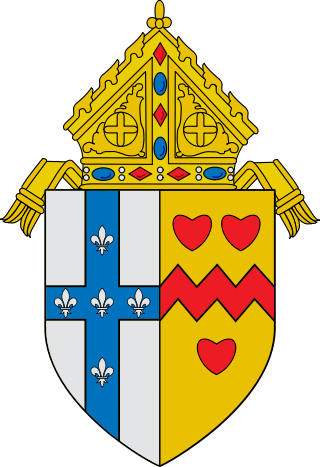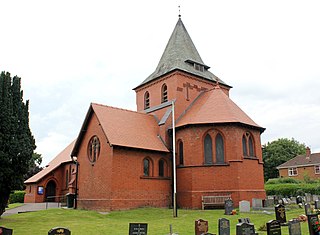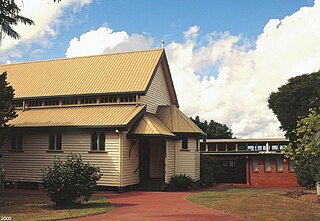
Walsingham is a civil parish in North Norfolk, England, famous for its religious shrines in honour of Mary, mother of Jesus. It also contains the ruins of two medieval monastic houses. Walsingham is 27 miles northwest of Norwich.

The Anglican Use, also known as Divine Worship, is a use of the Roman Rite celebrated by the personal ordinariates, originally created for former Anglicans who converted to Catholicism while wishing to maintain "aspects of the Anglican patrimony that are of particular value" and includes former Methodist converts to Catholicism who wish to retain aspects of Anglican and Methodist heritage, liturgy, and tradition. Its most common occurrence is within parishes of the personal ordinariates which were erected in 2009. Upon the promulgation of Divine Worship: The Missal, the term "Anglican Use" was replaced by "Divine Worship" in the liturgical books and complementary norms, though "Anglican Use" is still used to describe these liturgies as they existed from the papacy of John Paul II to present.

Our Lady of Walsingham is a title of Mary, mother of Jesus venerated by Catholics and High Church Anglicans associated with the Marian apparitions to Richeldis de Faverches, a pious English noblewoman, in 1061 in the village of Walsingham in Norfolk, England. Lady Richeldis had a structure built named "The Holy House" in Walsingham which later became a shrine and place of pilgrimage.

St Michael's Church is the principal Anglican church for Camden Town in north London. The present building, built in the late 19th century, was designed by George Frederick Bodley and Thomas Garner in a Gothic Revival style.

Saint Augustine's, Kilburn, is a Church of England church in the area of Kilburn, in North London, England. Because of its large size and ornate architecture, it is sometimes affectionately referred to as "the Cathedral of North London", although the church is not a cathedral in any official sense.

Holy Trinity Church stands to the north of the village of Bickerton, Cheshire, England. The church is recorded in the National Heritage List for England as a designated Grade II listed building. It is an active Anglican parish church in the diocese of Chester, the archdeaconry of Chester, and the deanery of Malpas. Its benefice is combined with those of St Wenefrede, Bickley, St John, Burwardsley and All Saints, Harthill.

All Saints Anglican Church is a heritage-listed church at 32 Wickham Terrace, Spring Hill, City of Brisbane, Queensland, Australia. First founded in 1862, the current building designed by Benjamin Backhouse was completed in 1869, making it the oldest Anglican church in Brisbane. For most of its history, it has been identified with the High Church or Anglo-Catholic tradition within Anglicanism. It was added to the Queensland Heritage Register on 21 October 1992.

St Mary Star of the Sea is a Roman Catholic parish church in West Melbourne, Victoria, Australia. The foundation stone of the church was laid in 1882 and the building was completed by 1900. Since 2002, restoration has been ongoing to restore the church to its original state. Built with seating for over 1,200 people, it has been described as the largest parish church in Melbourne, in Victoria, or even in Australia.

St James the Great, St Kilda East, is an Anglican parish church in the Melbourne suburb of City of Glen Eira in Victoria, Australia.

The Personal Ordinariate of Our Lady of Walsingham in England and Wales is a personal ordinariate in the Latin Church of the Catholic Church immediately exempt, being directly subject to the Holy See. It is within the territory of the Catholic Bishops' Conference of England and Wales, of which its ordinary is a member, and also encompasses Scotland. It was established on 15 January 2011 for groups of former Anglicans in England and Wales in accordance with the apostolic constitution Anglicanorum coetibus of Pope Benedict XVI, which was supplemented with the Complementary Norms of Pope Francis in 2013.

All Saints Church, Great Saughall, is located in Church Road in the civil parish of Saughall and Shotwick Park, formerly Saughall and before that Great Saughall, in the county of Cheshire, England. It is an active Anglican parish church in the deanery of Wirral South, the archdeaconry of Chester, and the diocese of Chester. The church is recorded in the National Heritage List for England as a designated Grade II listed building.

The Sacred Heart Church is a Roman Catholic church located in St Kilda, Melbourne, Victoria in Australia. The church is of architectural, aesthetic and historical significance and was built in stages, is one of the major landmarks of St Kilda.

Christ Church is a heritage-listed church at 24 Macrossan Street, Childers, Bundaberg Region, Queensland, Australia. It was designed by John Hingeston Buckeridge and built from 1900 to 1958. It is also known as the Anglican Church. It was added to the Queensland Heritage Register on 28 April 2000.

St Andrew's Brighton is the oldest continuous Anglican church in Victoria, Australia. St Andrew's is the Anglican parish church of the beachside suburb of Brighton, Melbourne.

The Church of Our Lady of the Assumption and St Gregory is a Catholic church on Warwick Street, Westminster. It is the oldest Catholic church in England. It was formerly known as the Royal Bavarian Chapel, because like several Catholic churches in London it originated as a chapel within a foreign embassy. It was built between 1789 and 1790 to the designs of Joseph Bonomi the Elder. The only surviving eighteenth-century Catholic chapel in London, it is a Grade II* listed building. The parish is now operated by the Personal Ordinariate of Our Lady of Walsingham, the British personal ordinariate for the Anglican Use within the Catholic Church.

The Cathedral of Our Lady of Walsingham in Houston, Texas, is a Catholic church that serves as the cathedral of the Personal Ordinariate of the Chair of Saint Peter.

St Richard of Chichester Church is a Roman Catholic parish church in Chichester, West Sussex, England. The church was built in 1958 and contains the largest scheme of stained glass by Gabriel Loire in the United Kingdom. The church is situated on Market Avenue on the corner of Cawley Road, next to St Richard's Catholic Primary School. It is a Grade II listed building.

St Agnes, Kennington Park, is an Anglo-Catholic church in south London in the Diocese of Southwark, though it is under the episcopal oversight of the Bishop of Fulham. The church is situated in the Borough of Southwark placed behind Kennington Park and near the Oval Cricket Ground. The nearest tube stations are Kennington and Oval.
St Mary and All Saints Church is the parish church of Little Walsingham in the English county of Norfolk. It is dedicated to the Virgin Mary and All Saints. Little Walsingham was the location of the shrine of Our Lady of Walsingham, destroyed at the Dissolution. The Anglican shrine was revived by Alfred Hope Patten, the Vicar of Little Walsingham, in 1922, and the image of Our Lady of Walsingham was in the church until its translation to the new priory in 1931.






























